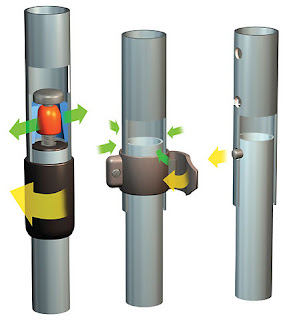Extension or Telescoping poles: the locking system
If your read the entry about poles the other day you know the entry took a different path but I did leave it as it was. I had not thought about going in to the aspects of telescoping poles. One of the readers wanted a bit of clarification on the locking mechanism that are used to keep the length of the pole in place and then allow it to be collapsed back down. I said I would put in a quick entry and here it is.
Sunday morning found me reading my e-mail and a question form a reader popped up, could I explain the locking mechanism on the pole just a bit more. I have a few examples of the locking styles that I have seen, used or been around. I know you can find more styles out there or systems using a combination of these locks.
I mentioned in the last blog a few styles, but a picture is worth a thousand words and may help in starting to understand the locking types.
The cam lock
The cam lock has been around for a long time and is use on several styles of poles. Though with water fed poles it has a draw back, you can not run your water line inside of the pole. There are some companies that use cam locks still and just run the water line on the outside of the pole. I see a lot of window washing poles are still external feed poles. Cam lock's also can be the knurled end is fitted into the end of one pole then the off set plug locks against the side of the other pole holding them in place.
To lock this in place you twist the poles in opposite directions. An
other draw-back is smaller poles are harder to grip when wet.
 |
| cam lock device |
The twist lock or locking cone lock
This is the oldest style use on most water fed poles or pressure washing heavy duty ones you may encounter. It work by tighten the large cone shaped ring on fingers under it to pinch or tighten against the smaller pole inside. You tighten the cone shape barrel by twisting it the tighter you do now the harder it is to undo later. I have had trouble getting grime in the fingers and over-tightening is a problem. Keeping it clean and a genteel snug to tighten it is all that is needed to keep this problem from happening.
 |
| The tappered cone is tightened down against the fingers locking the poles in place. |
 |
| Twist locks come in several sizes to work with the different diameters of the poles or tubing. |
Pin locks
This is a sure way to lock into one length it will not move or come loose with work it is a very positive way to keep the poles at the working length. I have never used one of these style of poles so I can not give you much feed back. One draw back is there are preset hole drilled into the pole giving you only the preset length, this is not a big deal though you are only less than six inches off.
 |
| Push the button it lifts or depresses the pin and you can slide out the pole to the desired length. |
 |
| Pin lock style lets you lock the pole into the desired length it is a very positive locking system. |
Lever lock or clamp lock
The last system I will look at is the lever lock it is a clamping system it has a clamp the is activated by a lever or a screw-nut. You use the leverage to tighten the internal pole against the out side of the sliding pole it is fixed onto the other pole keep it from moving. One disadvantage is the larger screw-nuts may get in the way but the smaller streamlined lever is less likely too. Over tighten may be a problem here too and breakage of the plastic lever.
 |
| the screw-nut type of locking clamp |
 |
| lever locking style of clamp lock |
 | |
| Typical arrangement of the telescoping pole what ever the locks they use the have a smaller pole inside of a larger pole and some type of locking system to keep it in place. |
Other styles of locks
You may see other style of locks too I found a few pictures.
I hope this will help to clear up some of your questions on the locking systems and how they work. All these locking systems work by pinching against the wall of the pole except the pin system. Keeping your pole at the desired length while working is all that is needed but being able to quickly change and adjust the length is where each may differ. This will all be up to each user of which system he or she will use. I have carpal tunnel in my hands and find the large twist locks the easiest to work with and have been using this system for a lot of years as I stated in the last blog entry. Thank you for reading our blog and please visit our web sites, links are on the right. As always call:
Cleaned by Pete at 417-459-7869 for all your power washing needs in Springfield and the Southwest MO area





No comments:
Post a Comment